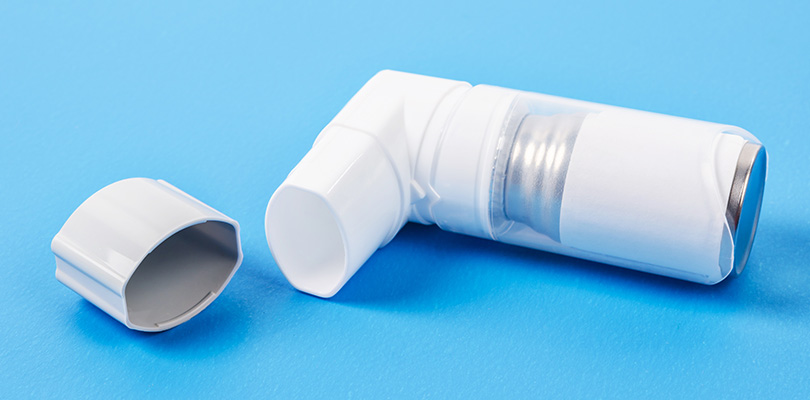Understanding Asthma Inhalers
Asthma is often treated with a variety of inhalers and medications. People with asthma should work together with their doctor to develop an asthma action plan that may include inhalers. Understanding how and when to take your asthma inhalers is vital to prevent symptoms and manage flare-ups.
Classification of Asthma Inhalers
Different classifications of asthma inhalers which are often used to treat asthma including the following:
Fast-Acting Asthma Inhalers
Fast-acting asthma inhalers are bronchodilators that relax the muscles of the airways. During an asthma attack, the airways constrict or narrow. A bronchodilator relaxes the muscles of the airway, which allows them to widen.
These fast-acting inhalers are often prescribed as needed when asthma symptoms, such as wheezing, chest tightness, and shortness of breath develop. Possible side effects of short-acting bronchodilators include anxiousness, increased heart rate, and trouble sleeping.
Examples of common fast-acting inhalers include:
- Albuterol
- Xopenex
Keep in mind; the active ingredient in many of the fast-acting inhalers is albuterol. But different manufacturers produce fast-acting inhalers containing albuterol. The following inhalers have different brand names and may have different inactive ingredients, but all contain the bronchodilator albuterol.
- ProAir
- Ventolin
- Proventil
Long-Acting Beta-Agonists
Long-acting beta-agonists are a type of asthma inhaler that helps control symptoms for 12 hours or longer. The inhalers target a receptor in the body that widens the airways, which eases symptoms.
The Food and Drug Administration recommends long-acting beta-agonists are used along with an inhaled corticosteroid when treating asthma. Common types of combination medications containing corticosteroids and long-acting beta-agonists include:
- Symbicort
- Advair
- Breo
Side effects of long-acting beta-agonists are similar to those of short-acting bronchodilators and may include increased heart rate, shakiness, and headache.
In rare instances, long-acting beta-agonists have been associated with severe asthma attacks. It’s essential to talk with your doctor about the risks and benefits to determine if it is the right type of medication for you.
Knowing how asthma and steroids are related is crucial for those with asthma because different types of steroids do different things. Find out more.
Corticosteroid Inhalers
Corticosteroid inhalers may also be prescribed to treat asthma. In addition to constriction of the airways, people with asthma also get inflammation in the lungs. Corticosteroids reduce swelling and inflammation in the airways. Side effects of steroid inhalers can include hoarseness, dry mouth, and oral yeast infection. Rinsing your mouth after taking a steroid inhaler can decrease your chances of side effects. Common types of corticosteroid inhalers include:
- Flovent
- Qvar
- Pulmicort
Types of Asthma Inhaler Devices
Asthma medications come in different delivery devices. Different medications may be available in different types of inhalers or may only be available in one device. Below are the most common types of asthma inhalers:
- HFA Inhalers: Both bronchodilators and corticosteroids are available in HFA inhalers.
- Diskus: Combination medications, such as Advair, and corticosteroids are available in diskus inhalers.
- Soft Mist Inhaler: Soft mist inhalers are a multidose hand-held device, which is propellant-free and delivers medication in the form of an aerosol. It is easy to use, and the small particle size allows it to be delivered deeper into the airways than traditional metered dose inhalers.
- RespiClick Inhaler: A RespiClick is a new inhaler delivery device. RespiClick delivers medication in the form of a dry powder. Currently, Proair is available in a RespiClick inhaler. Using a RespiClick requires a deep, fast inhalation to take each dose of medication.
Other Types of Asthma Treatments
In addition to inhalers, other treatment may be recommended to treat asthma. The specific treatment may depend on the severity of symptoms and the type of asthma a person has. For example, omalizumab may be used to treat allergy-induced asthma.
During an allergy-asthma attack, the immune system overreacts to a substance. The immune system reacts by releasing antibodies, which can cause allergy and asthma symptoms. Omalizumab works by blocking the antibodies that are released, which prevents asthma symptoms.
Omalizumab is administered through an injection, which is given every two to four weeks. It is usually not prescribed for children under the age of 12.
Using an Asthma Inhaler Correctly
Whatever type of asthma inhaler is prescribed, it is vital to use it correctly. Using your inhaler wrong can increase the chances of side effects. Incorrect use also decreases the amount of medication deposited into your lungs.
Each inhaler may be taken differently. It’s important to follow the manufacturer’s directions. For example, some inhalers require a quick, forceful inhalation while others require a slow inhalation.
Before taking an inhaler, it’s helpful to exhale all the air out of your lungs. Also, make sure get a good seal with your lips around the mouthpiece of the inhaler.
After you inhale, try to hold your breath for a few seconds, which allows the medication to be absorbed into the lung tissue more efficiently.
If you use an HFA inhaler, be sure to attach a spacer. A spacer is a tube-like device that allows you to inhale slower. The slower inhalation helps more medication get deposited into your lungs.
For those using a steroid inhaler, be sure to rinse your mouth to prevent side effects. It’s also important to track symptoms and talk to your doctor about adjusting your inhalers as needed.







